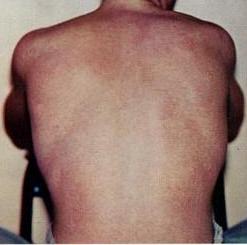
Dengue fever is a mosquito-borne disease caused by dengue virus, prevalent in tropical and subtropical areas. It is frequently asymptomatic; if symptoms appear they typically begin 3 to 14 days after infection. These may include a high fever, headache, vomiting, muscle and joint pains, and a characteristic skin itching and skin rash. Recovery generally takes two to seven days. In a small proportion of cases, the disease develops into severe dengue with bleeding, low levels of blood platelets, blood plasma leakage, and dangerously low blood pressure.

Incubation period is the time elapsed between exposure to a pathogenic organism, a chemical, or radiation, and when symptoms and signs are first apparent. In a typical infectious disease, the incubation period signifies the period taken by the multiplying organism to reach a threshold necessary to produce symptoms in the host.

Arbovirus is an informal name for any virus that is transmitted by arthropod vectors. The term arbovirus is a portmanteau word. Tibovirus is sometimes used to more specifically describe viruses transmitted by ticks, a superorder within the arthropods. Arboviruses can affect both animals and plants. In humans, symptoms of arbovirus infection generally occur 3–15 days after exposure to the virus and last three or four days. The most common clinical features of infection are fever, headache, and malaise, but encephalitis and viral hemorrhagic fever may also occur.
James (Jim) Chin is a public health epidemiologist. He works in public health surveillance and prevention of communicable diseases, particularly AIDS.
Tropical diseases are diseases that are prevalent in or unique to tropical and subtropical regions. The diseases are less prevalent in temperate climates, due in part to the occurrence of a cold season, which controls the insect population by forcing hibernation. However, many were present in northern Europe and northern America in the 17th and 18th centuries before modern understanding of disease causation. The initial impetus for tropical medicine was to protect the health of colonial settlers, notably in India under the British Raj. Insects such as mosquitoes and flies are by far the most common disease carrier, or vector. These insects may carry a parasite, bacterium or virus that is infectious to humans and animals. Most often disease is transmitted by an insect bite, which causes transmission of the infectious agent through subcutaneous blood exchange. Vaccines are not available for most of the diseases listed here, and many do not have cures.
The UK statutory notification system for infectious diseases is a system whereby doctors are required to notify a "proper officer" of the local authority if they are presented with a case of a serious infectious disease such as diphtheria or measles. The proper officer then sends a report to the Centre for Infections of the Health Protection Agency (HPA) in Colindale, north London.

Disease surveillance is an epidemiological practice by which the spread of disease is monitored in order to establish patterns of progression. The main role of disease surveillance is to predict, observe, and minimize the harm caused by outbreak, epidemic, and pandemic situations, as well as increase knowledge about which factors contribute to such circumstances. A key part of modern disease surveillance is the practice of disease case reporting.
A notifiable disease is any disease that is required by law to be reported to government authorities. The collation of information allows the authorities to monitor the disease, and provides early warning of possible outbreaks. In the case of livestock diseases, there may also be the legal requirement to kill the infected livestock upon notification. Many governments have enacted regulations for reporting of both human and animal diseases.
David L. Heymann is an American infectious disease epidemiologist and public health expert, based in London.
The National Institute of Virology in Pune, India is an Indian virology research institute and part of the Indian Council of Medical Research (ICMR). It was previously known as 'Virus Research Centre' and was founded in collaboration with the Rockefeller Foundation. It has been designated as a WHO H5 reference laboratory for SE Asia region.

Mosquito-borne diseases or mosquito-borne illnesses are diseases caused by bacteria, viruses or parasites transmitted by mosquitoes. Nearly 700 million people contract mosquito-borne illnesses each year, resulting in more than a million deaths.
Christopher Mores is an American (US) arbovirologist, trained in infectious disease epidemiology. He is a professor in the Department of Global Health at the Milken Institute School of Public Health, the program director for the Global Health Epidemiology and Disease Control MPH program, and is director of a high-containment research laboratory at the George Washington University in Washington, DC.

John S. Marr is an American physician, epidemiologist, and author. His professional life has concerned outbreaks of infectious disease and thus his subsequent writing career has focused on that topic, particularly historical epidemics.

Robert Ellis Shope was an American virologist, epidemiologist and public health expert, particularly known for his work on arthropod-borne viruses and emerging infectious diseases. He discovered more novel viruses than any person previously, including members of the Arenavirus, Hantavirus, Lyssavirus and Orbivirus genera of RNA viruses. He researched significant human diseases, including dengue, Lassa fever, Rift Valley fever, yellow fever, viral hemorrhagic fevers and Lyme disease. He had an encyclopedic knowledge of viruses, and curated a global reference collection of over 5,000 viral strains. He was the lead author of a groundbreaking report on the threat posed by emerging infectious diseases, and also advised on climate change and bioterrorism.

John Payne Woodall (1935–2016), known as Jack Woodall, was an American-British entomologist and virologist who made significant contributions to the study of arboviruses in South America, the Caribbean and Africa. He did research on the causative agents of dengue fever, Crimean–Congo hemorrhagic fever, o'nyong'nyong fever, yellow fever, Zika fever, and others.
The Norwegian Institute of Public Health is responsible for maintaining and revising the list of notifiable diseases in Norway and participates in the European Centre for Disease Prevention and Control (ECDC) and the World Health Organization's surveillance of infectious diseases. The notifiable diseases are classified into Group A, Group B and Group C diseases, depending on the procedure for reporting the disease.
In the United States, the National Notifiable Disease Surveillance System (NNDSS) is responsible for sharing information regarding notifiable diseases. As of 2020, the following are the notifiable diseases in the US as mandated by the Centers for Disease Control and Prevention:

The Division of Global Migration Health (DGMH), formerly the Division of Global Migration and Quarantine is the part of the U.S. government responsible for U.S. Quarantine Stations and issuing quarantine orders. It is part of the National Center for Emerging and Zoonotic Infectious Diseases within the Centers for Disease Control and Prevention (CDC).

The Public Health Regulations 1988, created by the Department of Health and Social Care, came into force on 1 October 1988 and was associated with the previous Public Health Act 1984. 24 more diseases were added, indicating exact control powers that could be applied to individual diseases.










